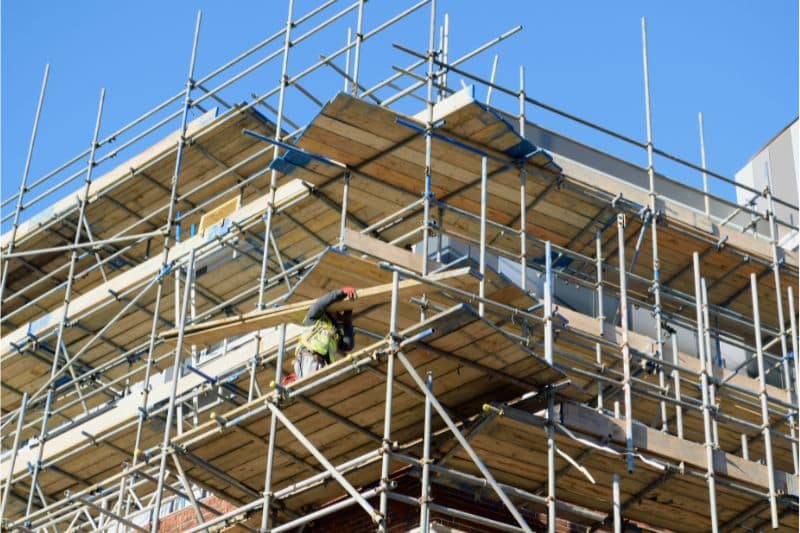Are you physically fit and have a good head for heights? Do you like working outdoors? How about complying with OH&S standards and adapting to varying work demands? Becoming a scaffolder could be just the right job in the construction industry for you.
Most construction projects require a scaffolder. So there is usually plenty of work for scaffolder job seekers.
Why is a Scaffolder Needed on a Construction Site?

It is rare to find a building site that doesn’t need a scaffolder. Labourers erect scaffolding that provides a safe and stable platform for working at heights or in places that are difficult to reach.
A scaffolder eliminates the need for work crews to descend and ascend to and from ground level when travelling at heights on site. Though it is temporary, scaffolding is built strong enough to support equipment and materials.
From the plans, the scaffolder works out a solution within defined space parameters. A scaffolder works with a system of platforms and pulleys. Scaffolders assemble scaffolding equipment such as planks, support braces, guard rails, toe boards, ladders, scaffolding wheels, scaffolding poles and safety netting.
There are 8 types of scaffolding: aerial, cantilever, single, double, patented, supported, suspended and trestle. The two most common scaffolding materials used in Australia are aluminium and steel. After assessing the site, scaffolders choose what is most appropriate for the job.
What is the Role of a Scaffolder?

As scaffolding is used for many purposes, each job has different requirements. In any one day, a scaffolder may need to:
- understand and work from blueprints
- assemble pipes, clamps and braces together
- lay planks for flooring in a way that takes the load of people and materials
- put scaffolding sections in place and secure them
- fix ladders, rails and other attachments to the scaffold
- alter a pre-existing scaffold so it is fit for the next part of the project
- dissemble scaffolding after completion of a project.
Construction projects that require scaffolding include constructing new buildings, repairing existing ones, adding new storeys, construction maintenance, building bridges, cleaning external high-rise windows and building inspections.
The Scaffolder and OH&S
Health and safety are of paramount importance. Scaffolders are responsible for minimising risks in their area of the work site. Dangerous situations can be avoided if the scaffolder takes number of precautions:
- Observe vehicle and foot traffic and work in progress around the scaffold.
- Check ground conditions.
- Calculate what will be on the scaffold, e.g. live load maximums, dead loads and accessibility needs.
- Inspect all scaffolding before and after use – does it need maintenance or repairs?
- Ask workers on the scaffold if they have noticed any issues.
- Review the incident and injury records and take special note of any “near misses”.
Scaffolders need to work safely and be highly aware at all times of potential OH&S issues. Attention to detail and a good level of concentration are also beneficial.
What Do You Need to be a Scaffolder?

First, scaffolding work is physically demanding so you must be fit and strong. You will be required to lift wooden platforms, metal piping and parts, tools (hammers, spanners and socket wrenches), chemicals and heavy objects while working at heights. It is obvious that scaffolding is a high-risk occupation.
Having exceptional balance is an advantage. Be prepared to work in a range of locations and hours, and in most weather conditions.
Second, to work as a scaffolder in Australia, it is mandatory that you are able to show a log of work experience. You also need to obtain a Construction Induction Training Card, also known as a White Card. The nationally recognised qualification is a High Risk Work Licence for Scaffolding. There are three classes of scaffolding licences available: basic, intermediate and advanced. Depending on where you are working, you may also need to complete a short course on safety in working at heights.
A school leaver, someone re-entering the workforce, an adult wishing to for a career change and a secondary school student via VET in Schools area all eligible to apply for apprenticeships or traineeships. A level 3 apprenticeship in scaffolding usually takes 12 months to finish.
Third, you will need a current drivers licence because you will need to drive scaffolding equipment to and from the building site. Come with your own safety gear such as helmets, harnesses, work boots and tool belts as the construction manager on site may not supply these.
Career Opportunities for Scaffolders

More work opportunities open up to a qualified scaffolder if they specialise. Specialised areas of scaffolding deliver increased rates of pay.
If you enjoy music, why not conduct a job search for erecting structures for bands, concerts and music festivals? You could find yourself in demand. Other sectors of the arts and entertainment industry that need scaffolding include industry award nights, fashion shows and outdoor art installations.
Your scaffolding experience plus some extra education and training could land you a job as a rigger. Riggers move heavy structural objects by using mechanical equipment such as derricks and jibs.
How Much Do Scaffolders Get Paid in Australia?
The average Australian scaffolder is paid $85,000 per year; that is, $43.59 per hour. The average salary for a first-year scaffolder is around $70,000 per year. An experienced scaffolder can take home up to $118,000 per annum.
Where to Find Work as a Scaffolder
If you are a scaffolder wanting work, why not talk to Fast Labour Hire. We match workers in the construction industry with the right partners. We have many construction site managers who are looking for scaffolders.
Contact Fast Labour Hire today or email us at info@fastlabourhire.com.au.

